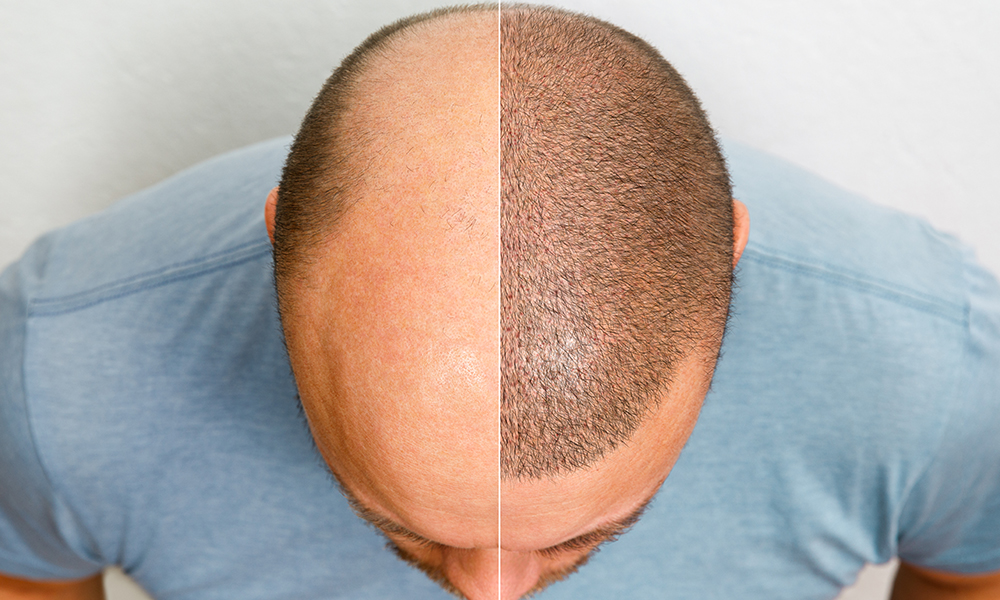-
 Toll Free No 9146-744-744
Toll Free No 9146-744-744 - Appointment
Hair transplant is a day-care procedure in which hair follicles are collected from the thicker part of the scalp and implanted under local Anesthesia over the bald area of the scalp.
One of the 3 Types of Surgery is chosen depending upon the patient’s condition.
A small part of the scalp which has maximum hair follicles is cut into many tiny bits of hair follicle grafts which are transplanted into the bald areas
.
Hair Follicular units are directly punched out from the scalp and individually grafted precisely in tiny holes made in the bald areas.
A DHI Implanter is used to remove hair follicles from the donor area which are processed into grafts. These hair follicle grafts are implanted in the recipient areas.
Hair Fall is the commonest condition affecting the population. From youths to adults, every 3 people out of 5 are currently affected with low to severe hair fall. It can be a temporary phase or may become permanent until complete baldness occurs. It is seen that Males (80%) are affected almost twice the number of females (40%).

FUT HAIR TRANSPLANT (FOLLICULAR UNIT TRANSPLANTATION)
A small part of the scalp which has maximum hair follicles is cut into many tiny bits of hair follicle grafts which are transplanted into the bald areas.
DHI HAIR TRANSPLANT (DIRECT HAIR IMPLANTATION)
A DHI Implanter is used to remove hair follicles from the donor area which are processed into grafts. These hair follicle grafts are implanted in the recipient areas.
FUE HAIR TRANSPLANT (FOLLICULAR UNIT EXTRACTION)
Hair Follicular units are directly punched out from the scalp and individually grafted precisely in tiny holes made in the bald areas.
NON-SURGICAL TREATMENT OPTIONS
There are free options, but they are not the gold standard and vary in effectiveness. Thus, the selection of non-surgical options should be done under the guidance of an expert. PRP (Platelet Rich Plasma) treatment is done by aggregating platelets from patients’ blood and then it is injected into the bald scalp area wherein it stimulates the growth of hair follicles. Minoxidil and Finasteride are the two commonest drugs used in a particular spectrum of patients. Laser therapy is a painless, non-invasive method where the hair follicles are stimulated to grow. Scalp Tension Reduction is done for hair fall due to rising scalp tension. Micro-Needling is done by injecting needles into the scalp to promote inflammation, blood supply, and growth of hair follicles. Hair Replacement is done on a certain base that is tightly secured to the scalp. It can be skin or polymer. The hair is then matched according to the type, texture, length, etc., and firmly stitched, looped, or knotted up for natural-looking hair.


As the age increases, the problems of hair fall also exaggerate. Several other factors play a significant role in hair fall:
Widening part: If you part your hair and notice your part getting wider, it might be a sign of hair thinning.
Receding hairline: Similarly, if you notice your hairline looking higher or wider than usual, it may be also a sign of thinning hair.
Loose hair: Check your brush or comb after using it. Do you notice more hair than usual? If so, this may be a sign of hair loss.
Bald patches: These can range in size and can grow over time.
Clogged drains: When you notice your sink or shower drains are clogged with hair
Pain or itching: If you have a hidden skin condition causing hair loss, you might also feel pain or experience itching on your scalp.
So depending upon the Cause and Extent of Baldness and the quality of intact Hair, our expert Hair Transplant Surgeons would advise accordingly.
Hair transplant is a safe procedure with the use of local Anesthesia and intravenous sedation, thus the discomfort during the entire procedure is almost minimized.
It is a simple procedure with impressive results, but those who have chronic health issues like heart disease, kidney or liver failure, diabetes, etc. may not be suitable for hair transplant surgery.
The FUI hair transplant has a success rate of 95-98% when performed under the guidance of an expert.
The very next day!
You can colour your hair six months after hair transplant surgery because the chemical in the colour can affect the transplanted grafts.
You can start working after 2 days as long as it does not require any physical effort or wearing a helmet. Otherwise, you can resume working 10 days after a hair transplant.
It is not recommended to play and participate in any strenuous physical activity for a month after the hair transplant procedure. You can start with light exercises in the gym after two weeks. Strenuous exercises or physical activity should be avoided because elevated blood pressure on the scalp can put undue stress on the newly grafted hair follicles.
There is no need to visit. You will have to visit for only a couple of days. If you have any doubts, you can call or email your doctor.
Hair transplantation is the only permanent solution for hair restoration. The cost and expenses depend on the area of baldness and the number of grafts required. Consult your surgeon for more detailed information about the surgery cost.
Since this is a cosmetic surgery procedure, it won’t be covered under health insurance. For more details, you can consult our Hospione Team.
OUR PROCESS IS EASY contact us for More information.
Copyright © 2023 hospione.com - All Rights Reserved | Developed by Digital Marketing StudioGenix LLP